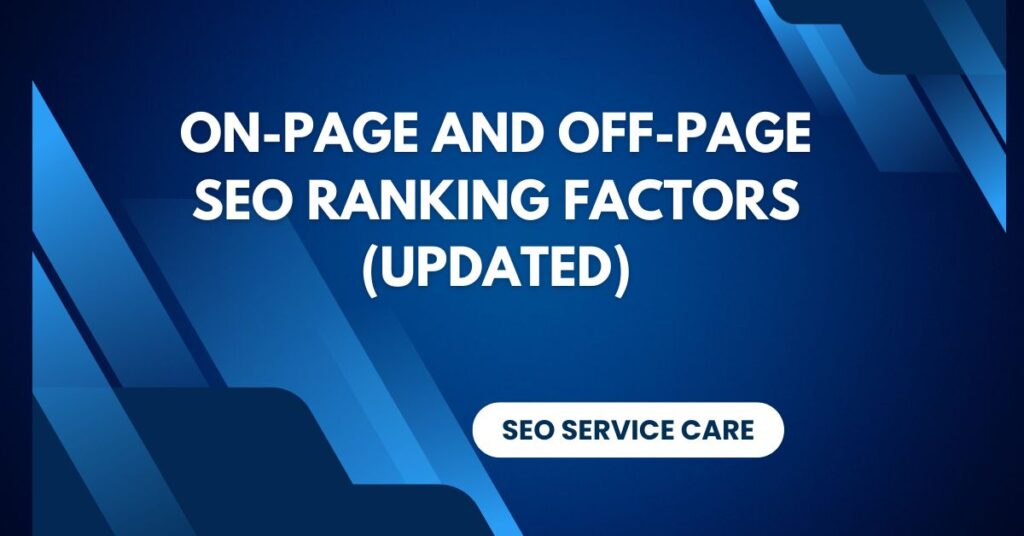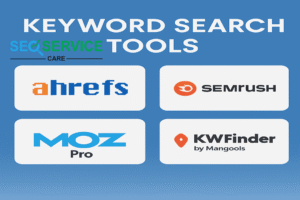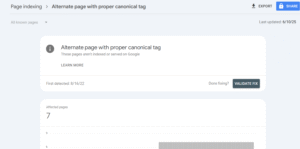Welcome to our deep dive into on-page and off-page ranking factors! If you’re like most website owners, you’re always looking for ways to improve your site’s visibility and drive more organic traffic. Well, you’re in luck! Today, we will break down the essential elements affecting your website’s search engine rankings and beyond. By the end of this blog, you will have a clearer idea of optimizing your site and building those organic keyword rankings. Let’s start!
Understanding On-Page SEO Ranking Factors
On-page SEO ranking factors refer to elements directly controlled on a webpage to improve search engine visibility. These include optimized content with relevant keywords, proper use of HTML tags (like title and meta description), fast loading times, mobile responsiveness, and internal linking. Effective on-page SEO ensures pages are easily discoverable and rank higher in search engine results pages (SERPs).
Content Quality
Content quality refers to the relevance, usefulness and level of engagement of the information presented on a webpage. High-quality content meets user intent, provides valuable insights, and is structured in clear language. It has originality, depth and credibility, which satisfies both search engines and users, resulting in increased SEO and user experience metrics such as bounce rate and time on page.
Relevance and Keyword Usage
Relevance in SEO pertains to how closely content matches search intent and user queries. Keyword usage involves strategically incorporating relevant keywords into content to enhance its visibility in search engine results, balancing natural language with SEO optimization for better rankings and user engagement.
Readability and User Experience
Readability in content refers to how easily users can understand and consume information. Factors include clear structure, concise sentences, and appropriate language for the audience. User experience (UX) encompasses overall satisfaction when interacting with a website, influenced by navigation ease, page speed, mobile-friendliness, and intuitive design. Both readability and UX are critical for retaining visitors and improving SEO performance.
Meta Tags and Description
Meta tags are HTML elements that provide metadata about a webpage. The meta description is a concise summary of the page’s content displayed in search engine results. Optimizing meta tags involves using relevant keywords and accurately describing the page to attract clicks and improve SEO rankings. Well-crafted meta descriptions can enhance click-through rates by enticing users with a compelling preview of the page’s content.
Creating Effective Meta Titles
Creating effective meta titles involves crafting concise, descriptive titles that accurately reflect the webpage’s content. Key considerations include:
-
Relevance: Ensure the title directly relates to the content and includes primary keywords.
-
Length: Keep it within 50-60 characters to avoid truncation in search results.
-
Clarity: Make it clear and understandable for both users and search engines.
-
Uniqueness: Each page should have a unique meta title to differentiate it from others on your site.
-
Compelling: Include persuasive elements like benefits or calls to action to attract clicks.
Focusing on these aspects can help you create meta titles that improve SEO visibility and encourage users to click through to your website.
Writing Compelling Meta Descriptions
Writing compelling meta descriptions is crucial for enticing users to click through to your website from search engine results pages. Here are key tips for creating effective meta descriptions:
-
Length: Keep it concise (around 150-160 characters) to ensure it displays fully in search results.
-
Relevance: Summarize the content accurately to match user intent and include primary keywords naturally.
-
Unique Value Proposition: Highlight unique aspects or benefits of your content that differentiate it from competitors.
-
Call to Action: Encourage engagement with a clear call to action (e.g., “Learn more,” “Discover,” “Shop now”).
-
Emotional Appeal: Use language that evokes curiosity, urgency, or emotion to capture attention.
-
Formatting: Use proper grammar, punctuation, and formatting (e.g., bullets, numbers) for clarity and readability.
-
Avoiding Duplication: Ensure each meta description is unique for every page to avoid confusion and improve relevance.
Crafting compelling meta descriptions helps improve click-through rates and enhances overall SEO performance by driving qualified traffic to your website.
Technical SEO Elements
Technical SEO elements are backend optimizations that improve a website’s search engine crawling, indexing, and overall performance. Key elements include:
-
Site Speed: Ensure fast loading times to improve user experience and SEO rankings.
-
Mobile-Friendliness: Optimize for mobile devices to cater to mobile users effectively.
-
Crawlability: Ensure search engines can crawl and index your site easily by using proper robots.txt and XML sitemaps.
-
SSL Certificate: Secure your site with HTTPS to build trust and improve SEO rankings.
-
Structured Data: Implement schema markup to help search engines understand content better and display rich snippets.
-
Canonical Tags: Use canonical tags to indicate preferred URLs for duplicate or similar content.
-
XML Sitemap: Create and submit an XML sitemap to help search engines discover and prioritize your site’s pages.
-
Site Architecture: Optimize site structure for logical navigation and internal linking, enhancing user experience and SEO.
By addressing these technical SEO elements, you can improve your website’s visibility, usability, and performance in search engine results.
Dive into Off-Page SEO Ranking Factors
Off-page SEO refers to actions that impact your search engine rankings outside your website. Key off-page SEO ranking factors include:
Backlinks
Backlinks are incoming links from external websites to your site. They are crucial for SEO as they signal to search engines that your content is valuable and trustworthy. Quality backlinks from authoritative sites improve your site’s authority and search engine rankings. However, relevance and the natural acquisition of backlinks are key to avoiding penalties and maintaining SEO effectiveness.
Quality vs Quantity
1. Quality Backlinks:
-
From authoritative and trusted websites.
-
Relevant to your industry or niche.
-
Natural and organic acquisition.
-
High domain authority and trust flow.
-
Contextual links within relevant content.
2. Quantity of Backlinks:
-
Total number of backlinks pointing to your site.
-
It can include links from various sources.
-
Should maintain quality for quantity.
-
More is beneficial if it is from reputable sources.
-
Avoid spammy or low-quality links.
Obtaining High-Authority Links
To obtain high-authority links, consider the following strategies:
-
Content Quality: Create valuable, informative content others want to link to.
-
Outreach: Reach out to influencers, bloggers, and journalists who may find your content relevant.
-
Guest Blogging: Contribute articles to reputable sites in your industry.
-
Broken Link Building: Find broken links on high-authority sites and suggest your content as a replacement.
-
Partnerships: Collaborate with complementary businesses for mutual link-sharing opportunities.
-
Directories and Listings: Submit your site to high-quality directories and listings relevant to your industry.
Online Brand Mention
Online brand mentions referring to instances where your brand is discussed or referenced across the internet, regardless of whether a hyperlink is included. They contribute to your online presence and reputation, impacting SEO and credibility. Monitoring and engaging with brand mentions helps manage reputation, build authority, and earn backlinks from mentions that don’t initially include links.
Building a Strong Online Reputation
Building a strong online reputation involves the following steps:
-
Consistent Brand Messaging: Maintain a clear and positive brand image across all platforms.
-
Quality Content: Create valuable, relevant content that resonates with your audience.
-
Engagement: Interact with customers and respond promptly to feedback and inquiries.
-
Reviews and Testimonials: Encourage satisfied customers to leave positive reviews and testimonials.
-
Transparency: Be open and honest in your communications and business practices.
-
Monitor Mentions: Use tools to monitor brand mentions and promptly address issues.
-
Influencer Relationships: Collaborate with influencers to amplify positive perceptions of your brand.
-
Community Involvement: Participate in relevant communities and events to build trust and visibility.
Benefits of Influential Partnerships
Benefits of influential partnerships include:
-
Expanded Reach: Tap into new audiences through your partner’s established following.
-
Credibility: Enhance your brand’s reputation by association with respected influencers.
-
Content Amplification: Co-create compelling content that resonates with a broader audience.
-
SEO Boost: Gain quality backlinks and improve search engine rankings.
-
Brand Awareness: Increase visibility and recognition in your industry.
-
Trust Building: Build trust with potential customers through trusted endorsements.
-
Collaborative Opportunities: Explore new marketing channels and innovative campaigns.
Integrating On-Page and Off-Page SEO Strategies
Integrating on-page and off-page SEO strategies involves aligning content optimization with external efforts to enhance website visibility. On-page strategies focus on content relevance, structure, and user experience, while off-page strategies emphasize building authority through backlinks and online reputation. Combining both ensures comprehensive SEO that attracts organic traffic and improves search engine rankings effectively.
Creating a Holistic SEO Plan
Creating a holistic SEO plan involves the following steps:
-
Keyword Research: Identify relevant keywords with high search volume and low competition.
-
On-Page Optimization: Optimize meta tags, headings, content, and images for targeted keywords.
-
Content Strategy: Develop high-quality, informative content that meets user intent.
-
Technical SEO: Ensure site structure, speed, and mobile-friendliness are optimized.
-
Off-Page SEO: Build authoritative backlinks and manage online reputation through brand mentions.
-
Analytics and Monitoring: Track performance with tools like Google Analytics and adjust strategies based on data.
Updating Content Regularly
Updating content regularly helps maintain relevance and SEO freshness signals, encouraging search engines to crawl and index your site more frequently. It improves user experience by providing current and accurate information, increasing engagement and reducing bounce rates. Additionally, regular updates can enhance organic traffic and search engine rankings over time.
Monitoring and adjusting your strategy
Monitoring and adjusting your strategy involves:
-
Analytics Review: Regularly assess performance metrics like traffic, conversions, and bounce rates.
-
SEO Audits: Conduct periodic audits to identify technical issues and opportunities for improvement.
-
Competitor Analysis: Stay updated on competitors’ strategies and adjust accordingly.
-
Content Updates: Refresh and optimize content based on keyword performance and user engagement.
-
Adaptation: Flexibly respond to algorithm updates and industry trends to maintain competitiveness.
Common Mistakes in On-Page and Off-Page SEO
Common mistakes in on-page and off-page SEO include:
Over-optimization
Over-optimization in SEO refers to excessive use of SEO tactics that can harm rather than help your website’s rankings. Common pitfalls include:
-
Keyword Stuffing: Excessively using keywords unnaturally in content.
-
Anchor Text Overuse: Using exact match anchor text excessively in backlinks.
-
Duplicate Content: Replicating content across multiple pages or domains.
-
Aggressive Link Building: Acquiring too many low-quality or irrelevant backlinks.
Over-optimization can lead to penalties from search engines, harming your site’s visibility and rankings.
Creating too many low-quality links
Creating too many low-quality links refers to acquiring backlinks from sources needing more authority or relevance, often through link farms or spammy directories. This practice can result in search engine penalties, adversely affecting your SEO performance and reputation. Acquiring high-quality, relevant backlinks from reputable sources is crucial to maintaining a strong and sustainable SEO strategy.
Ignoring User Experience
Ignoring user experience (UX) in SEO can lead to:
-
High bounce rates and low engagement.
-
Decreased time on site.
-
Negative impact on conversion rates.
-
Poor organic search performance.
-
Loss of potential customers and revenue.
Prioritize UX by:
-
Optimizing site speed and performance.
-
Ensuring mobile responsiveness.
-
Improving navigation and site structure.
-
Minimizing intrusive pop-ups and ads.
-
Providing valuable and relevant content.
Frequently Asked Questions on On-Page and Off-Page SEO
1. What is the difference between on-page and off-page SEO?
On-page SEO involves optimizing content and HTML elements within your website to improve search engine rankings. Off-page SEO focuses on external factors like backlinks, social signals, and online reputation to enhance authority and visibility.
2. How long does it take to see results from SEO efforts?
The time to see results from SEO efforts varies widely based on factors like competition, industry, and strategy. Generally, noticeable improvements can take several months to over a year, depending on the effectiveness and consistency of SEO practices implemented.
3. Can social media activity affect my SEO?
Yes, social media activity can indirectly impact SEO. While social signals (such as likes, shares, and comments) do not directly influence rankings, active social media presence can lead to increased brand visibility, traffic, and potential for natural backlinks—all of which can positively impact SEO performance.
4. What are some easy wins to improve my on-page SEO?
To improve on-page SEO:
-
Optimize titles, headings, and content with relevant keywords.
-
Write compelling meta tags.
-
Ensure high-quality, valuable content.
-
Use internal links effectively.
-
Optimize image alt text.
5. How important are backlinks in today’s SEO landscape?
Backlinks remain crucial in SEO as they signal authority and trust to search engines, influencing rankings. Quality backlinks from reputable sites are more valuable than quantity, demonstrating relevance and authority in today’s SEO landscape.
6. Should I focus more on on-page or off-page SEO?
Both on-page and off-page SEO are essential for a comprehensive SEO strategy. Focus on on-page SEO to optimize your website’s content and technical aspects. Simultaneously, invest in off-page SEO to build authority through quality backlinks and manage your online reputation effectively.
7. What tools can help me with my SEO strategy?
Essential SEO tools include Google Analytics for traffic insights, Google Search Console for performance monitoring, keyword research tools like Google Keyword Planner, Semrush, and Ahrefs, SEO audit tools such as Moz and Semrush, and backlink analysis tools like Ahrefs and Majestic SEO. These tools help optimize and monitor website performance effectively.






